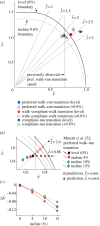Vaulting mechanics successfully predict decrease in walk-run transition speed with incline
- PMID: 23325739
- PMCID: PMC3639764
- DOI: 10.1098/rsbl.2012.1121
Vaulting mechanics successfully predict decrease in walk-run transition speed with incline
Abstract
There is an ongoing debate about the reasons underlying gait transition in terrestrial locomotion. In bipedal locomotion, the 'compass gait', a reductionist model of inverted pendulum walking, predicts the boundaries of speed and step length within which walking is feasible. The stance of the compass gait is energetically optimal-at walking speeds-owing to the absence of leg compression/extension; completely stiff limbs perform no work during the vaulting phase. Here, we extend theoretical compass gait vaulting to include inclines, and find good agreement with previous observations of changes in walk-run transition speed (approx. 1% per 1% incline). We measured step length and frequency for humans walking either on the level or up a 9.8 per cent incline and report preferred walk-run, walk-compliant-walk and maximum walk-run transition speeds. While the measured 'preferred' walk-run transition speed lies consistently below the predicted maximum walking speeds, and 'actual' maximum walking speeds are clearly above the predicted values, the onset of compliant walking in level as well as incline walking occurs close to the predicted values. These findings support the view that normal human walking is constrained by the physics of vaulting, but preferred absolute walk-run transition speeds may be influenced by additional factors.
Figures


 : multiples of the passive step frequency assuming a point mass pendular swing-leg of leg length.
: multiples of the passive step frequency assuming a point mass pendular swing-leg of leg length.  : normalized step length (step length/leg length). (b) A more extensive previous study [5] shows somewhat lower step length at preferred walk–run transition speed over a range of inclines, but (c) the change in relative velocity lies within the prediction if either
: normalized step length (step length/leg length). (b) A more extensive previous study [5] shows somewhat lower step length at preferred walk–run transition speed over a range of inclines, but (c) the change in relative velocity lies within the prediction if either  or
or  are treated as constant.
are treated as constant.Similar articles
-
Compass gait mechanics account for top walking speeds in ducks and humans.J Exp Biol. 2008 Dec;211(Pt 23):3744-9. doi: 10.1242/jeb.023416. J Exp Biol. 2008. PMID: 19011215 Free PMC article.
-
Preferred gait and walk-run transition speeds in ostriches measured using GPS-IMU sensors.J Exp Biol. 2016 Oct 15;219(Pt 20):3301-3308. doi: 10.1242/jeb.142588. J Exp Biol. 2016. PMID: 27802152
-
Inverted pendular running: a novel gait predicted by computer optimization is found between walk and run in birds.Biol Lett. 2010 Dec 23;6(6):765-8. doi: 10.1098/rsbl.2010.0256. Epub 2010 May 19. Biol Lett. 2010. PMID: 20484229 Free PMC article.
-
Biomechanical and physiological aspects of legged locomotion in humans.Eur J Appl Physiol. 2003 Jan;88(4-5):297-316. doi: 10.1007/s00421-002-0654-9. Epub 2002 Nov 13. Eur J Appl Physiol. 2003. PMID: 12527959 Review.
-
The puzzle of the walk-to-run transition in humans.Gait Posture. 2021 May;86:319-326. doi: 10.1016/j.gaitpost.2021.03.035. Epub 2021 Apr 3. Gait Posture. 2021. PMID: 33839426 Review.
Cited by
-
An instrumented centrifuge for studying mouse locomotion and behaviour under hypergravity.Biol Open. 2019 Jun 14;8(6):bio043018. doi: 10.1242/bio.043018. Biol Open. 2019. PMID: 31189660 Free PMC article.
-
The role of stride frequency for walk-to-run transition in humans.Sci Rep. 2017 May 17;7(1):2010. doi: 10.1038/s41598-017-01972-1. Sci Rep. 2017. PMID: 28515449 Free PMC article.
-
The muscle-mechanical compromise framework: Implications for the scaling of gait and posture.J Hum Kinet. 2016 Sep 10;52:107-114. doi: 10.1515/hukin-2015-0198. eCollection 2016 Sep 1. J Hum Kinet. 2016. PMID: 28149398 Free PMC article.
References
-
- Raynor AJ, Yi CJ, Abernethy B, Jong QJ. 2002. Are transitions in human gait determined by mechanical, kinetic or energetic factors? Hum. Mov. Sci. 21, 785–80510.1016/S0167-9457(02)00180-X (doi:10.1016/S0167-9457(02)00180-X) - DOI - DOI - PubMed
-
- Hreljac A. 1993. Preferred and energetically optimal gait transition speeds in human locomotion. Med. Sci. Sports Exerc. 25, 1158–116210.1249/00005768-199310000-00012 (doi:10.1249/00005768-199310000-00012) - DOI - DOI - PubMed
-
- Kram R, Domingo A, Ferris DP. 1997. Effect of reduced gravity on the preferred walk–run transition speed. J. Exp. Biol. 200, 821–826 - PubMed
-
- Usherwood JR. 2005. Why not walk faster? Biol. Lett. 1, 338–34110.1098/rsbl.2005.0312 (doi:10.1098/rsbl.2005.0312) - DOI - DOI - PMC - PubMed
-
- Minetti AE, Ardigo LP, Saibene F. 1994. The transition between walking and running in humans: metabolic and mechanical aspects at different gradients. Acta Physiol. Scand. 150, 315–32310.1111/j.1748-1716.1994.tb09692.x (doi:10.1111/j.1748-1716.1994.tb09692.x) - DOI - DOI - PubMed
Publication types
MeSH terms
Grants and funding
LinkOut - more resources
Full Text Sources
Other Literature Sources

